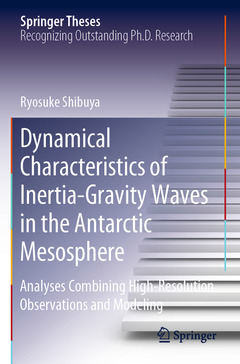Dynamical Characteristics of Inertia-Gravity Waves in the Antarctic Mesosphere, 1st ed. 2020 Analyses Combining High-Resolution Observations and Modeling Springer Theses Series
Auteur : Shibuya Ryosuke

Ryosuke Shibuya is a Postdoctoral Researcher in the Project Team for HPC Advanced Predictions utilizing Big Data Research Unit for Predictability of Global Weather Extremes, Japan Agency for Marine-Earth Science and Technology (JAMSTEC). He received his B.Sc., M.Sc. and Ph.D. from the University of Tokyo in March 2012, March 2014, and October 2017, respectively. He was awarded the Japan Society for Promotion of Science (JSPS) research fellowship for young scientists, and his research throughout his doctoral program was supported by the JSPS. He has also received a number of prizes and awards: the School of Science Research Award (Master) from the University of Tokyo in 2014, the best student oral presentation award at the American Meteorological Society’s 21th Symposium in 2014, and the School of Science Research Award (Ph.D.) from the University of Tokyo in 2017.
A prize-winning thesis, nominated for Springer Theses by the University of Tokyo
Reviews fundamental physics and important previous studies on inertia-gravity waves
Provides detailed descriptions of the behaviors of mesospheric gravity waves in the Antarctic
Discusses the importance of momentum depositions by large-scale inertia-gravity waves, which may be one of the key components to solving the cold bias problem
Date de parution : 08-2021
Ouvrage de 92 p.
15.5x23.5 cm
Date de parution : 01-2020
Ouvrage de 92 p.
15.5x23.5 cm
Disponible chez l'éditeur (délai d'approvisionnement : 15 jours).
Prix indicatif 52,74 €
Ajouter au panier


